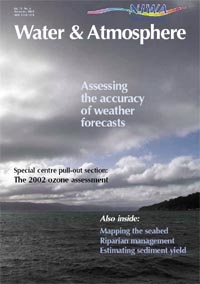
On this page
- What’s the UV today?
- NIWA scientist to head major international ocean project
- The oceans’ own “tuatara” discovered
- The high-tech world of lobster surveillance
- Award for NIWA climatologist
- Inventory of New Zealand greenhouse gas emissions, 2001
What’s the UV today?
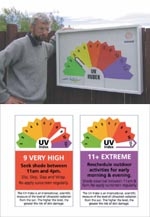
NIWA has developed a real-time UV display in consultation with the Cancer Society and SunSmart. The first prototype is currently installed at the new Molyneux Aquatic centre in Alexandra. The display incorporates a detector designed to measure the sun-burning UV from the sun and sky that strikes a horizontal surface. The instrument senses the current UV intensity, amplifies the signal, and then displays the result by moving a pointer on a scale (using the same servo technology used in model aircraft).
The current intensity of UV is depicted in terms of the internationally agreed UV Index (UVI) scale. The UVI scale was originally used in Canada, where its maximum value was designed to reach 10. In New Zealand, the peak UVI can exceed 13 near midday in summer.
The scale is subdivided into five different regions corres-ponding to five different behavioural responses that the Cancer Society is promoting. For UVI values less than 3, the risk is “low” and the colour code is green. UVI values exceeding 10 are designated as “extreme” and colour-coded purple.
The display is solar powered, making it useful for outdoor sporting events (e.g., tennis, cricket, athletics, etc.). Regular calibrations are needed to ensure that these instruments stay accurate and we are seeking sponsors to cover the costs of calibrations.
Units like the one shown should be available for use in summer 2004/05, under a “lease-to-buy” arrangement.
For more information, contact: Dr Richard McKenzie NIWA Lauder Private Bag 50061 Omakau Central Otago Phone +64 3 447 3411 Fax +64 3 447 3348 [email protected]

NIWA scientist to head major international ocean project
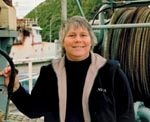
NIWA scientist Julie Hall has recently been appointed Chair of the Scientific Steering Committee for a new international oceanographic project that will focus on understanding the effects of global change on marine ecosystems.
The project – Integrated Marine Biogeochemistry and Ecosystem Research (IMBER) – will study the complex food webs of the coastal and deep ocean as well as organisms from the deep ocean that have never been studied before. It is part of the International Geosphere–Biosphere Programme (IGBP) based in Sweden, and will involve over 500 scientists from more than 20 countries over the next 10 years.
"We've had a great international response to this programme already, with 370 scientists from 27 countries attending a conference about IMBER in Paris earlier this year," said Dr Hall. "During this conference we identified a number of priority areas for research, including the effects on the marine environment of climate change, a decline in biodiversity, increased nutrients from coastal waters, and a growing human population."
Dr Hall said the committee will be made up of leading scientists from a number of countries, including USA, France, Germany, India, UK, Canada, and Japan. New Zealand research will contribute to the project, including through NIWA’s current ocean ecosystem programme. IGBP and SCOR (the international Scientific Committee for Oceanic Research, based in the US) fund IMBER’s Scientific Steering Committee, but it is up to the individual countries to fund the research.
"If at the end of my 3-year term I've got this project in the water with as many countries as possible on board, and have managed to get the natural and social scientists working together, then I'll be happy," said Dr Hall.
For further information, contact: Julie Hall NIWA PO Box 11115 Hamilton Phone +64 7 856 7026 Fax +64 7 856 0151 [email protected]

The oceans’ own “tuatara” discovered
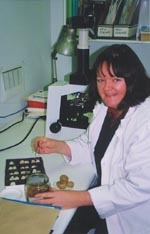
A species of sponge previously thought to be extinct has been found living at depths of between 400 and 900 m on undersea mountains off northeast New Zealand.
NIWA marine biologist and sponge expert Michelle Kelly, Daphne Lee (University of Otago), and John Buckeridge (Auckland University of Technology) made the link between the living species and the fossils of these sponges, which are found on land at Kakanui, North Otago.
Thirty-five million years ago Pleroma aotea, a white sponge with a distinctive round shape, lived in shallow waters between 50 and 100 m deep near a volcano at what is now Kakanui, near Oamaru. Now it is found only in deeper environments on seamounts and banks in northern New Zealand waters.
Like the tuatara, this sponge is one of only a small group of living animals that have survived in refuge environments. In the past, species of the sponge genus Pleroma were found in Europe as well as New Zealand. However, today there are only three known living species of this genus and they are all found in one place – the northern Norfolk Ridge and the waters off northern New Zealand. This makes these sponges “living fossils” and unique national treasures. We also know that this living fossil sponge (and its more common relatives) produce chemicals that have potential biomedical applications.
The change in where these sponges live is significant, and is due to their need for water rich in dissolved silica out of which they make their skeletons. Oceans today have much less silica near their surface available to plants and animals than they did 25 million years ago. Why? About 20 million years ago microscopic plants called diatoms became really abundant. Diatoms need silica to build their skeletons, and have taken up most of the silica in modern oceans, leaving little for other organisms.
NIWA has collected samples of Pleroma aotea from the Tui Seamount, the Three Kings Ridge, the Wanganella Bank, and Rumbles Seamounts northeast of New Zealand during field research to investigate the biodiversity of seamounts.
Michelle Kelly Janet Grieve
For more information, contact: Michelle Kelly Shanks NIWA Private Bag 109 695 Newmarket Auckland Phone +64 9 375 2050 Fax +64 9 375 2051 [email protected]

The high-tech world of lobster surveillance

A joint research programme between NIWA and the Tasmanian Aquaculture and Fisheries Institute (TAFI) is using high-tech acoustic tracking equipment to investigate the feasibility of releasing captive-reared one-year-old spiny lobsters back into their natural environment. These juveniles are being released to compensate for those removed as tiny puerulus (very young lobsters) for commercial aquaculture, and to enhance local populations. To be certain that these captive-reared lobsters will know how to behave in the wild, we are studying their movement after release to assess survival, foraging distance and shelter selection.
The equipment that makes these investigations possible is the Vemco Radio Acoustic Positioning System (VRAP), on loan to TAFI in Hobart. The system tracks animals using real-time position information generated by underwater acoustic transmitters. A series of three buoys and a two-way radio link the signals to a base station. An expendable pinger can be inserted internally or attached externally to the animal for tracking (see photo).
Young lobsters generally live in large aggregations, so we placed our tagged individuals in large rocky dens with like-sized wild lobsters and followed their movements for several days. But there are limitations, particularly when working with small benthic animals in a rocky environment. Not surprisingly, the fondness of lobsters for sheltering in the back of rocky dens plays havoc with the acoustic signal and produces large aberrant tracks in the data. Passing vessels and rough weather also interrupt the accuracy of the signal by bouncing the buoys around, so choosing a reasonably sheltered area for operating the equipment is essential. However, we can clean up the data based on our understanding of what is reasonable movement for the animal of interest, and what is absolutely impossible. The end result is high-resolution movement information that would otherwise be impossible to collect.
Megan Oliver, NIWA, Wellington (PhD Student, TAFI, University of Tasmania) Caleb Gardner, David Mills, TAFI, University of Tasmania Alison MacDiarmid, NIWA, Wellington

Award for NIWA climatologist

Dr John Kidson, who until recently lead NIWA’s climate dynamics research group in Wellington, was the 2003 recipient of the International Journal of Climatology prize. The award was initiated in 2002 and is presented annually to acknowledge the contribution made to the science of climatology by an individual through publication of their work in the Journal.
In the announcement of the award, editor Dr Glenn R. McGregor said: “Dr Kidson has had a prodigious career as a climate scientist. He graduated from the University of Canterbury in New Zealand with an MSc (Hons) in Physics in 1963. Soon after he started with the New Zealand Meteorological Service as a trainee research meteorologist. His potential in this area was recognised by being selected to undertake study towards an ScD in Meteorology at the Massachusetts Institute of Technology (MIT) in the USA, which was completed in 1968. The PhD thesis title was The General Circulation of the Tropics. In many ways this work inspired a career that has focused in large part on understanding the mechanisms and climate outcomes of tropical–extratropical interactions and associations between large-scale atmospheric circulation and local to regional scale climate and ecosystem variability. His published work, much of it in the International Journal of Climatology, has benefited the climate science community through providing it with the fundamental climate science for the development of seasonal to inter-annual climate prediction models. The award of the 2003 International Journal of Climatology prize acknowledges Dr Kidson’s standing as a climatologist of international acclaim.”
The prize was presented at the Royal Meteorological Society’s 2003 conference in Norwich, UK, in September. John Kidson was unfortunately unable to attend, so the award was accepted on his behalf by colleague Dr David Frame of Oxford University.
Jim Renwick NIWA, Wellington

Inventory of New Zealand greenhouse gas emissions, 2001
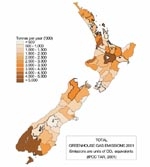
In November 2003 the web-mounted Inventory of New Zealand Greenhouse Gas Emissions was released under the National Centre for Climate–Energy Solutions. Total greenhouse gas emissions in 2001 for all Territorial Local Authorities in New Zealand are available, including the assumptions and formulae used to calculate the emissions.
The inventory contributes to the NIWA-led FRST-funded research programme “Urban Air Quality Processes” and is designed to help government departments, territorial authorities, industry, and other stakeholder groups to formulate effective policies for mitigating greenhouse gases and for other air quality issues.
Darren King National Centre for Climate–Energy Solutions
